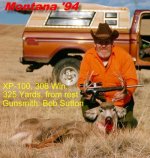R
Ramsh00ter
Guest
Dennis,
I read your posts all the time and you are among the guys that I pay attention to. You have a wealth of knowledge that I appreciate you sharing.
I am not trying to be argumenative, just offer an opinion.....
Can I prove a aftermarket lug is better, maybe, but prob not. To prove it, you would have to take more than one rifle, barrel them with the factory lug, then test. Then pull the barrels, set the shoulders back and test again.
Would that be a valid test, prob not. By putting the barrel back up in the lathe and cutting again, you are changing more than just the shoulder depth for the thicker lug, you are slightly changing the harmonics of the barrel. So any results could be questionable. It would require you to rebed the rifle, another variable that is difficult to control.
It is like so many things we do to make these things repeat, we do them because we gain confidence in the package. We eliminate a variable. But no body can prove they improve accuracy. So the debate goes on......
If we go through the trouble to square up an action, make everything concentric. Turn the tenion/shoulder of the barre square and concentric. Chamber the barrel to be precisely in line. Then put a stamped out washer between them, didn't we just throw away alot of that precission work? I think so.
With a lug that is absolutely flat and square increases our chances of removing a barrel and putting it back on with the same tension and stress. I don't believe you can do that with a factory lug. JMHO
So in response to you challenge, I can't prove it, nor have I, nor do I intend to try. But I will continue to use either an aftermarket lug or one that has been surface ground to be flat and square.
Do I thinky your wrong, nope! But I think you are leaving something on the table by short cutting a cheap step.
Randy
I like and use Holland lugs because they are the same size as the receiver and they look good...
That being said, in my opinion it is a toss up if it will shoot any better than with the factory lug...
Has anyone actually tested the difference in accuracy between a factory lug that may be out 1/2 thou and a lug that is dead true?... with all other things equal... not an anecdotal case, but an actual test...? Show the results please ...
I read your posts all the time and you are among the guys that I pay attention to. You have a wealth of knowledge that I appreciate you sharing.
I am not trying to be argumenative, just offer an opinion.....
Can I prove a aftermarket lug is better, maybe, but prob not. To prove it, you would have to take more than one rifle, barrel them with the factory lug, then test. Then pull the barrels, set the shoulders back and test again.
Would that be a valid test, prob not. By putting the barrel back up in the lathe and cutting again, you are changing more than just the shoulder depth for the thicker lug, you are slightly changing the harmonics of the barrel. So any results could be questionable. It would require you to rebed the rifle, another variable that is difficult to control.
It is like so many things we do to make these things repeat, we do them because we gain confidence in the package. We eliminate a variable. But no body can prove they improve accuracy. So the debate goes on......
If we go through the trouble to square up an action, make everything concentric. Turn the tenion/shoulder of the barre square and concentric. Chamber the barrel to be precisely in line. Then put a stamped out washer between them, didn't we just throw away alot of that precission work? I think so.
With a lug that is absolutely flat and square increases our chances of removing a barrel and putting it back on with the same tension and stress. I don't believe you can do that with a factory lug. JMHO
So in response to you challenge, I can't prove it, nor have I, nor do I intend to try. But I will continue to use either an aftermarket lug or one that has been surface ground to be flat and square.
Do I thinky your wrong, nope! But I think you are leaving something on the table by short cutting a cheap step.
Randy


